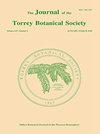榕树和桐树(仙人掌科)桐树关节的抗压/拉应力和木质化细胞
IF 0.8
4区 生物学
Q4 PLANT SCIENCES
引用次数: 1
摘要
与植物分离。弯曲应力(仅由于树枝的重量)是主要应力(平均弯曲应力为167和383 kPa)。Ficus-indica和0。茎节之间的分枝(分别为分枝)。与弯曲应力相比,两种物种的轴向、剪切和扭转应力相对较低。数据为0。Ficus-indica和0。Parryi var. Parryi结果表明,同一节理的拉伸部分木质部细胞木质化比例分别为23.6%和25.3%,而压缩部分木质部细胞木质化比例分别为10.8%和14.7%。木质化木质部细胞在关节的压缩、拉伸和侧向部分的相对径向位置为0。Ficus-indica和0。对Parryi和Parryi进行了分析。总的来说,木质部细胞在关节的拉伸组织中比在压缩组织和外侧组织中更靠近外表面。因此,木质化的木质部细胞位于提供高水平抗弯曲的位置。两种植物的最大弯曲应力与关节木质部木质化细胞的数量呈正相关。为0。ficus-indica的最佳拟合线为y = 1.48 x + 24.2 (P = 0.012), r2 = 0.76。为0。最佳拟合线为y = 54.0 x - 11.7 (P = 0.01), r2 = 0.92。1.48的斜率值为0。与54.0坡度值相比,榕树指数较低。Parryi var, Parryi。一个物种的大斜率值可能反映木质化木质部细胞抵抗压力的能力更强。在已有资料的5种机会种中,坡值与关节直径之间存在较强的负相关关系。然而,高斜率值出现在茎段水平的物种中。总的来说,这些结果表明,弯曲应力是茎节之间的主要应力,茎节中木质化的木质部细胞提供了对关节应力的主要抵抗能力,并且应力与木质化木质部细胞数量的斜率值可能与植物形态有关。本文章由计算机程序翻译,如有差异,请以英文原文为准。
Compressive/tensile stresses and lignified cells as resistance components in joints of Opuntia ficus-indica and Opuntia parryi var. parryi (Cactaceae)
to being separated from the plant. Bending stress (due solely to the weight of the branches) was the predominant stress (mean bending stresses were 167 and 383 kPa for 0. ficus-indica and 0. parryi var. parryi, respectively) between stem segments. Axial, shear, and torsion stresses were relatively low compared with bending stresses for both species. Data of 0. ficus-indica and 0. parryi var. parryi show that 23.6 and 25.3% of tensile portions of joints were composed of lignified xylem cells, respectively, while compressive portions of the same joints had only 10.8 and 14.7% lignified xylem cells, respectively. The relative radial positions of lignified xylem cells for compressive, tensile and lateral portions of joints for 0. ficus-indica and 0. parryi var. parryi were analyzed. In general, lignified xylem cells were closer to the external surface in tensile tissues than in compressive and lateral tissues of joints. Thus, lignified xylem cells are located in a position to provide a high level of resistance to bending. Maximum bending stresses were positively related with amounts of lignified xylem cells in joints for both species. For 0. ficus-indica the best-fit line was y = 1.48 x + 24.2 (P = 0.012) with an r2 = 0.76. For 0. parryi var. parryi, the best-fit line was y = 54.0 x - 11.7 (P = 0.01) with an r2 = 0.92. The 1.48 slope value for 0. ficus-indica was low compared with the 54.0 slope value for 0. parryi var. parryi. Large slope values for a species may reflect a greater ability of lignified xylem cells to resist stress. In five Opuntia species for which data are available, there was a strong negative relationship between slope values and joint diameter. However, high slope values occurred in species with more horizontal stem segments. Overall, these results show bending stress is the main stress between stem segments, lignified xylem cells in stem joints provide the main resistance to joint stresses, and slope values of stress versus amounts of lignified xylem cells may be related to plant morphology.
求助全文
通过发布文献求助,成功后即可免费获取论文全文。
去求助
来源期刊
CiteScore
0.70
自引率
0.00%
发文量
16
审稿时长
>12 weeks
期刊介绍:
The Journal of the Torrey Botanical Society (until 1997 the Bulletin of the Torrey Botanical Club), the oldest botanical journal in the Americas, has as its primary goal the dissemination of scientific knowledge about plants (including thallopyhtes and fungi). It publishes basic research in all areas of plant biology, except horticulture, with an emphasis on research done in, and about plants of, the Western Hemisphere.

 求助内容:
求助内容: 应助结果提醒方式:
应助结果提醒方式:


